Let’s be honest, “compliance” can feel like a heavy word, right? In Australia’s ever-shifting business world, it’s not just a fancy term; it’s the backbone of what makes a business trustworthy, respected, and successful in the long run.
Think of it like this: trying to keep up with all the rules and regulations can feel like wandering through a giant, confusing maze. One wrong turn, and you could be facing hefty fines or a dent in your reputation. That’s where a solid compliance management system (CMS) steps in – your trusty compass for this journey.
A well-chosen compliance management system (CMS) can lighten the load for Australian businesses, whether you’re a startup just finding your feet or a seasoned enterprise. It helps you tidy up your processes, sidestep potential pitfalls, and clearly show that you’re playing by the rules. But with so many options popping up, how do you pick the one that truly fits? It’s a bit like choosing the right tool for a particular job.
So, let’s examine Australia’s top 10 compliance management system providers. We’ll discuss each of their offerings, helping you pinpoint the perfect match for your organisation. No more guessing games!
1. Sentrient Workplace Compliance System
Imagine having a friendly guide for all things workplace compliance. That’s Sentrient. They’ve built an online workplace compliance system that’s a real lifesaver, especially for small and medium businesses, although big companies find it helpful too. Their main goal is to ensure you’re covered regarding safety, privacy, and tricky issues like bullying or discrimination.
What it Does (Key Features):
- Ready-to-go online courses: These are quick courses, all legally checked, covering standard workplace rules and regulations.
- Policy builder: Helps you whip up your workplace rules without a fuss.
- Audit-ready reports: Need to show you’re compliant? They’ve got reports waiting for you.
- Keep track: Easily see who’s completed what and where you stand.
- Handle incidents: A straightforward process for when things go wrong.
- Automate tasks: Takes the grunt work out of repetitive processes.
- HR help: Beyond compliance, it even helps with hiring, onboarding, and keeping employee documents organised.
- Smart compliance: Uses some AI magic to make things smoother.
The Good Bits (Pros):
- Super-fast setup: You can often get going in minutes – no kidding!
- No hidden setup costs: What you see is what you get.
- Covers a lot: A solid all-rounder for HR and workplace compliance.
- Strong on safety: Focuses on keeping your workplace safe and fair.
- People like their support: Good reviews for their customer service.
Things to Consider (Cons):
If your business is in a super-regulated industry (like finance or heavy industry), it might focus more on general workplace stuff and less on those deeper, industry-specific regulations.
Compared to vast, enterprise-level systems, complex customisation might be limited.
Best Suited for: Small to medium businesses, or even larger organisations, who primarily want an efficient and affordable way to handle all their workplace compliance – think HR, WHS, and keeping everyone behaving well.
Pricing: You must contact Sentrient directly for a tailored free demo and a quote. They don’t list public prices, which often depends on your needs.
2. RiskWare Compliance Software
Imagine having one central brain for all your business’s risks and rules. That’s RiskWare. They offer a vast platform that combines Governance, Risk, and Compliance (GRC) with Health, Safety, and Environment (HSE). The best part? They’re Australian-owned and have a local team to help you, which is always a bonus!
What it Does (Key Features):
- Massive module library: Over 80 pieces cover almost every GRC and HSE need.
- One place for everything: All your laws, rules, and company policies kept neatly together.
- Risk smarts: Helps you manage big-picture company risks, daily operational risks, and even IT security risks.
- Health & Safety champion: From tracking incidents to managing hazards and safe work methods.
- Audit from start to finish: Guides you through the entire audit process.
- Keep things running: Tools for business continuity and information security.
- Make it your own (no code!): You can tweak things to fit your business without needing a tech guru.
- AI assistant: Their “SOCRAITES Copilot” uses AI to automate tasks and make GRC + Safety smarter.
- Plays well with others: Connect with systems like LexisNexis for legal updates.
- On the go: Access it from your phone, even offline.
The Good Bits (Pros):
- Super comprehensive: It covers the whole GRC and HSE spectrum.
- Easy to use: People find it quite intuitive, even with all its power.
- Aussie pride: Australian-owned means local support and development that understands our unique landscape.
- Flexible: That “no-code” customisation is a huge plus.
- Smart automation: AI helps take much of the manual work away.
- Security focus: They take data security seriously.
Things to Consider (Cons):
Because it’s so robust and comprehensive, it might be more than a smaller business needs (and potentially a bigger investment).
For big or complex setups, getting everything right during implementation could take more time.
Best Suited for: Medium to large businesses, government departments, and organisations that need an integrated and complex solution for managing all their GRC and HSE across different parts of the company.
Pricing: They don’t share prices publicly. You’ll need to chat with RiskWare directly for a quote specific to your needs.
3. SafetyCulture (formerly iAuditor) – Compliance Management
You might know them as iAuditor, famous for digital checklists. But SafetyCulture has grown into a powerhouse for keeping operations humming smoothly. Their platform lets teams do inspections, report problems, and manage compliance no matter where they are. While inspections are their bread and butter, they have some serious muscle for wider compliance management.
What it Does (Key Features):
- Easy digital inspections: Say goodbye to paper forms; do your audits and checks digitally.
- Spot a problem, report it fast: If you see something wrong, you can log it immediately.
- Your templates, your way: Highly customisable templates mean it fits how you work.
- All your safety data in one spot: A central place for everything health and safety related.
- Works on your phone: Perfect for teams out in the field.
- Automatic reminders: Get alerts and follow-ups so nothing slips through the cracks.
- Smart insights: Powerful reports and analytics to help you see trends and make better decisions.
- Connects to other apps: Integrates with many third-party tools.
- AI for templates: A neat AI feature that can even help you create inspection templates.
The Good Bits (Pros):
- Fantastic mobile app: It’s a game-changer for on-site work and instant reporting.
- Highly adaptable: You can tweak checklists and workflows to match almost any process.
- Great reporting: Helps you dig into the data and spot patterns.
- Grows with you: Works whether you’re small or large.
- Free plan: You can get started without spending a cent, which is rare.
Things to Consider (Cons):
- Some users have mentioned that customer support can sometimes be a bit slow to respond.
- For huge teams, the cost can add up, especially if you’re looking for broader HR tools beyond just inspections.
- Don’t expect time tracking or payroll features here; it’s focused on operations and compliance.
Best Suited for: Any size business, but especially good for those with teams on the ground doing lots of inspections and quality checks and needing to report issues quickly, like construction, retail, or manufacturing.
Pricing:
- Free Plan: Up to 10 users, five inspection templates, and 3 years of data storage – a great way to try it out.
- Premium Plan: $24 per monthly user (billed yearly). This gets you unlimited everything.
- Enterprise Plan: You’ll get a custom quote for bigger organisations needing specific features and setups.
- Lite seats: A budget-friendly option for limited inspection access at $5 per monthly user.
4. DoDiligenz
DoDiligenz is all about simplifying the often-tangled web of compliance. They offer an online platform designed to help Australian businesses manage their legal duties and risks, aiming to make compliance less daunting.
What it Does (Key Features):
- One place for all obligations: Keeps track of all your compliance requirements in a central hub.
- Risk tools: Help you assess and manage potential risks.
- Action tracking: Keeps tabs on who needs to do what, and when.
- Reports for audits: Generate the reports you need to prove compliance.
- Document library: Stores all your essential compliance documents.
- Timely reminders: Get alerts for upcoming deadlines so you don’t miss a beat.
The Good Bits (Pros):
- Straightforward to use: Designed with simplicity in mind.
- Automates workflows: Helps take the manual effort out of compliance tasks.
- Clear picture: Gives you a quick and easy overview of your compliance status.
Things to Consider (Cons):
There’s less public information available about their specific features and user experiences compared to some of the bigger players.
You’ll likely need to contact them directly to understand if it fits your unique industry.
Best Suited for: Small to medium-sized Australian businesses looking for a simple, effective way to manage their core compliance obligations and risks without fuss.
Pricing: They don’t list prices publicly. You’ll probably need to request a demo and a quote.
5. Cited – Monitored Compliance
Cited takes a unique angle, focusing on “monitored compliance.” Their platform is about keeping tabs on your workforce’s compliance, such as licenses, certifications, and inductions, and ensuring everyone’s skills are up to date. They put a significant emphasis on seeing everything in real time and verifying credentials.
What it Does (Key Features):
- Auto-check workers: Automatically monitors if employees’ and contractors’ licenses and certifications are current.
- Expiry alerts: Get a heads-up when a document is about to expire.
- Digital verification: Tools to quickly check if credentials are legitimate.
- Online inductions: Manage your new starter inductions digitally.
- Contractor oversight: Helps you manage the compliance of all your third-party workers.
- Document storage: A safe place for all those important papers.
- Reporting & audit trails: Generate reports to show who’s compliant and who isn’t.
The Good Bits (Pros):
- Excellent for workforce compliance: This is a huge plus if your business relies heavily on certified staff or contractors.
- Saves admin time: Automated monitoring cuts down on heaps of manual checking.
- Reduces risk: Helps ensure everyone working for you is properly qualified and compliant.
- Better due diligence: It makes vetting employees and contractors easier.
Things to Consider (Cons):
- It’s quite specialised in workforce compliance. If you need broader GRC (Governance, Risk, Compliance) tools, you might need to pair them with another system.
- No public pricing means you must contact them directly for a quote.
Best Suited for: Businesses in industries where workforce competency is non-negotiable, like construction, mining, healthcare, and education. Also, any organisation that deals with many contractors will find this incredibly useful.
Pricing: Not available publicly. Contact Cited for a personalised quote.
6. WHSMonitor
If Work Health and Safety (WHS) is your focus, WHSMonitor is built specifically for you. This cloud-based software offers a complete solution to help businesses of all shapes and sizes keep their workplaces safe and meet all those crucial WHS legal requirements.
What it Does (Key Features):
- WHS Risk Management: Helps you find hazards, assess risks, and implement fixes.
- Incident tracking: A straightforward way to report and manage accidents or near-misses.
- People management: Keep tabs on training, competencies, and qualifications.
- Asset checks: Manage inspections and maintenance for equipment.
- Contractor management: Ensures your contractors are following WHS rules.
- Chemical safety: Helps you manage hazardous chemicals safely.
- Custom reports: Build your dashboards to see what matters most to you.
- Safety documents galore: A massive library of safety records and templates.
- Quality control: Features for document control and tracking non-conformances.
- Visitor management: It even helps manage who comes and goes on site.
The Good Bits (Pros):
- Laser-focused on WHS: It’s designed to do one thing well and shows.
- Easy to navigate: Users generally find it simple.
- Automates safety tasks: Frees up your time by automating many WHS processes.
- Ready-made packages: Offers quick setup options, especially for smaller businesses.
- Cloud-based: Access it from anywhere, anytime.
Things to Consider (Cons):
- Since it’s all about WHS, if your business has broader compliance needs outside of safety, you might need another system to cover those areas.
- For huge organisations, the employee-based pricing tiers could become quite costly.
Best Suited for: Businesses prioritising a dedicated, powerful Work Health and Safety compliance system. This is particularly true for small to medium businesses and those in industries with significant WHS risks.
Pricing: Starts at $500 per year. They also offer “plug-and-play” packages with tiered pricing for businesses with up to 100 employees.
7. aXcelerate – RTO Compliance
For those in vocational education and training, aXcelerate is a familiar name. The award-winning student management software is highly effective regarding RTO (Registered Training Organisation) compliance. It’s built to help RTOs, short course providers, and even VET in Schools and CRICOS organisations meet their regulatory demands.
What it Does (Key Features):
- Automated government reporting: Handles complex reports like AVETMISS, USI, RAPT, CRICOS, and VSL.
- Error spotter: Helps you find and fix issues in your compliance reports before they cause trouble.
- Quality goals: Manages tasks and goals linked directly to RTO Standards.
- Trainer tracking: Keeps an eye on trainer competencies and sends alerts for expiring qualifications.
- Easy enrolments: Streamlines online student sign-ups and assessments.
- Course setup: Create and manage all your training courses.
- Digital certificates: Generate certificates with a click.
- Offline assessments: Handy for assessments even when there’s no internet.
The Good Bits (Pros):
- Highly specialised: If you’re an RTO, this system speaks your language.
- Automates tricky reports: Takes the pain out of those detailed reports Australian RTOs have to submit.
- Smooth student management: Makes managing students and their progress much easier.
- ASQA friendly: Designed to help you stick to all the ASQA standards.
Things to Consider (Cons):
- This is very much a niche product. If you’re not in the education sector, it’s probably not for you.
- Pricing is likely structured for educational institutions, so it might not align with general business budgets.
Best Suited for: Registered Training Organisations (RTOs), VET providers, and any other Australian educational institution that needs specific compliance management for student data, reporting, and meeting regulatory standards.
Pricing: Listed as starting from $58. This is likely a base price, with custom quotes based on the RTO’s size and the modules required.
8. YakTrak – Compliance Management Software
YakTrak is often considered a performance management and HR tool, but its platform also includes a compliance management side. The company aims to make teams more accountable and streamline all those HR-related tasks.
What it Does (Key Features):
- Compliance meets performance: Manages your compliance needs right alongside performance reviews.
- Structured check-ins: Help you set up regular meetings and feedback loops.
- New employee setup: Smooth onboarding and development tools.
- Plays nice with others: Can connect with your existing HR systems.
- Data insights: Gives you analytics to help make decisions based on what’s happening.
The Good Bits (Pros):
- Easy to get started: It has a user-friendly and straightforward interface.
- All-in-one HR/compliance: Offers a holistic view, bringing HR and compliance together in one place.
- Builds accountability: Good for creating a workplace where everyone feels responsible for continuous improvement.
Things to Consider (Cons):
- The compliance features might not be as deep or detailed as a system solely dedicated to compliance.
- Some users have mentioned that customising reports can be a bit tricky.
- No mention of API access in some reviews, which could limit how well it connects to other, more complex systems.
- No free version, just a trial.
Best Suited for: Small to medium-sized businesses looking for a combined HR and performance management solution that handles basic employee-related compliance regulations.
Pricing: Starts from $10 per user per month. A free trial is available.
9. CS-VUE
CS-VUE is a compliance platform with a keen eye on environmental concerns and broader Governance, Risk, and Compliance (GRC) assessments. They’re all about seeing the “big picture” while allowing for a ton of customisation to fit your needs.
What it Does (Key Features):
- Environmental focus: Strong tools for managing environmental compliance and risks.
- Consent wizard: Helps manage all your environmental consents and permits.
- Smart connections: Can hook up to digital and environmental sensors (IoT data!) for real-time monitoring.
- Contractor oversight: Manage compliance for your external partners.
- Document control: Store, manage, and track versions of all your important papers.
- Alerts & reminders: Get notified about what to do and when.
- Easy reporting: Generate reports and export data to CSV.
- Location, location, location: Tag documents and clauses with their geographical location.
- Granular permissions: Control exactly who sees and does what.
The Good Bits (Pros):
- Unique environmental focus: If environmental compliance is big for you, their sensor integration is a standout.
- Robust integrations: Can pull data from various sources, which is powerful.
- Highly adaptable: You can shape it to your organisation’s unique demands.
- Big picture meets specifics: Provides both a broad overview and detailed insights into specific industry needs.
- Cloud-based: Access your compliance data from anywhere.
Things to Consider (Cons):
- If you have minimal environmental compliance needs, this system might be more powerful (and perhaps pricier) than you require.
- No public pricing suggests it’s likely a custom solution.
Best Suited for: Organisations with significant environmental obligations, those looking to integrate data from IoT sensors for monitoring, and businesses across various industries (like industrial, mining, energy, and infrastructure) that need a highly customisable GRC platform.
Pricing: Not publicly listed; they offer a free demo and trial.
10. SafetyChampion – Safety Planning & Compliance Management Software
True to its name, SafetyChampion is about championing your health and safety. It’s a versatile software designed to simplify compliance and risk management for businesses of any size. They aim to offer flexible workflows and real-time reporting to help you easily meet your safety responsibilities.
What it Does (Key Features):
- Incident management: Log and track any safety incidents.
- Audit tool: Helps you conduct and manage safety audits.
- Inspection app: Streamline your workplace inspections.
- Forms, forms, forms: Manage all your safety forms digitally.
- Training tracker: Keep records of all employee training.
- Custom workflows: Adapt the system to your specific safety processes.
- Live reporting: See what’s happening with your safety data in real-time.
- Mobile-friendly: Works on your iPhone, iPad, or Android device.
The Good Bits (Pros):
- Comprehensive safety features: Covers various health and safety aspects.
- Easy to use: Designed to be straightforward for users.
- Can be tweaked: You can customise it to fit your company’s unique needs.
- Free version available: A great way to try before you buy, especially for small teams.
- Good support: Offers various ways to get help (phone, email, live chat).
Things to Consider (Cons):
- The free version has tight limits (only two users, specific modules locked).
- Some public reviews are sparse, meaning a smaller user base or less online feedback.
- Like WHSMonitor, its primary focus is safety and WHS, so if you need broader compliance, keep that in mind.
Best Suited for: Businesses primarily looking to simplify and improve their health and safety compliance and risk management. It’s an excellent option for small businesses with its free and lower-tier plans, and it can grow with you.
Pricing:
- Safety Champion Light (Free): Limited to 2 users and specific modules.
- Silver: From $75/month, up to 5 users, but still with some module limitations.
- Gold: From $125/month, for up to 10 workers, with full access and customisation.
- Larger organisations will need to request a custom quote.
How to Pick Your Compliance Champion
Okay, so the Australian compliance scene is undeniably complex. But here’s the good news: you can flip the script with the right Compliance Management System. Instead of seeing compliance as a chore, it becomes a real asset – building trust, avoiding headaches, and boosting your overall business.
So, when you’re weighing your options up, ask yourself a few key questions:
- What’s your industry like, and what are your specific rules? Are you an RTO needing specific reporting? Do you have significant environmental impacts? Or is it all about WHS for your team? Make sure the system truly understands your world.
- How big is your business, and how much do you plan to grow? Can the system stretch and adapt as you expand, or will you outgrow it quickly?
- What features are non-negotiable? And will it play nicely with your current software? Think about what you need, and whether it can connect with the tools you use daily.
- Is it easy to use? Will your team want to use it? A fantastic system is useless if no one on your team can figure it out! Simplicity often leads to better adoption.
- What kind of support will you get? If you hit a snag, will someone be there to help you? And what about training to get everyone up to speed?
- What’s the cost, and is it a good investment? Does the pricing make sense for your budget, and are you getting real value for your money?
- You’ll be much stronger by considering these points and looking hard at these top Australian compliance management system (CMS) providers. You’ll not only find a solution that helps you tick all those compliance boxes, but one that helps build a more reliable, trustworthy, and less risky business. Good luck!
Frequently Asked Questions (FAQs)
We know navigating compliance can bring up a lot of questions. Here are some of the most common ones we hear about compliance management systems (CMS) in Australia:
Q1: What exactly is a compliance management system (CMS)?
A CMS is a structured framework or software designed to help businesses manage their legal and regulatory obligations, industry standards, and internal policies. It provides tools to identify, assess, monitor, and report on compliance risks, ensuring your organisation adheres to all necessary rules and laws. Think of it as your centralised hub for all things compliance.
Q2: Why is a compliance management system important for Australian businesses?
In Australia’s complex and ever-changing regulatory landscape, a compliance management system is crucial for several reasons:
- Avoids penalties: It helps prevent costly fines, legal action, and reputational damage from non-compliance.
- Builds trust: Demonstrating strong compliance fosters confidence with customers, partners, and regulators.
- Reduces risk: It helps you proactively identify and mitigate potential compliance risks before they become significant problems.
- Increases efficiency: Automates manual tasks, centralises data, and streamlines processes, saving time and resources.
- Improves decision-making: Provides clear, real-time insights into your compliance status.
- Fosters a culture of integrity: Encourages ethical behaviour and accountability across your organisation.
Q3: Can a small business benefit from a compliance management system, or is it just for large enterprises?
Absolutely! While large enterprises often have complex needs, small and medium businesses can benefit immensely from a compliance management system. Many providers offer affordable, scalable tailored solutions, helping to manage essential workplace compliance (like WHS and HR) without overwhelming resources. It protects them from significant risks they might not have the dedicated staff to manage manually.
Q4: What key features should I consider in a compliance management system?
When choosing a compliance management system, consider features like:
- Centralised obligation management: A single source for all your legal and regulatory requirements.
- Risk assessment tools: These are used to identify, evaluate, and mitigate risks.
- Automated alerts & notifications: To inform you of deadlines and changes.
- Reporting & audit trails: Essential for demonstrating compliance to regulators.
- Document management: Secure storage and version control for policies and records.
- Workflow automation: To streamline routine compliance tasks.
- Scalability: Can the system grow with your business?
- User-friendliness: Is it intuitive for your team to use?
Q5: How do I know which compliance management system is the “right” one for my business?
The “right” compliance management system depends entirely on your specific needs. Consider:
- Your industry: Does it have unique regulations (e.g., healthcare, finance, education)?
- Your business size: Are you a small startup or a large corporation?
- Your core compliance needs: Is it primarily WHS, HR, environmental, or broader GRC?
- Your budget: What are you prepared to invest?
- Integration needs: Does it need to connect with your existing HR, ERP, or other systems?
- Support and training: What level of help will the provider offer? We recommend using our blog post’s “Choosing Your Compliance Champion” section as a checklist!
Q6: What’s the difference between GRC and a standard CMS?
GRC stands for Governance, Risk, and Compliance. A GRC platform is typically a more comprehensive, integrated solution encompassing compliance, broader corporate governance, and enterprise-wide risk management. A standard compliance management system might focus purely on compliance obligations, whereas a GRC platform takes a more holistic view of an organisation’s strategic objectives, risks, and regulatory adherence. Many larger enterprises lean towards GRC for this integrated approach.
Q7: Can a compliance management system help with specific Australian regulations like WHS or Privacy Act compliance?
Many compliance management system providers, especially those with a strong presence in Australia, build their systems with specific local regulations in mind. You’ll find systems tailored for Work Health and Safety (WHS), those that simplify obligations under the Privacy Act, or even niche solutions for Registered Training Organisations (RTOs) or environmental regulations. Always check if a system explicitly supports the specific Australian laws relevant to your industry.
Q8: Are cloud-based compliance management system solutions secure?
Reputable cloud-based compliance management system providers invest heavily in security measures, including data encryption, regular security audits, multi-factor authentication, and robust backup protocols. They often have dedicated security teams and meet international security standards. Always inquire about their data security practices and where your data will be stored (ideally within Australia for many businesses).
Read More About Compliance Management System:
- The Role of AI and Machine Learning in Compliance Management
- Top 5 Compliance Challenges HR Professionals Face
- How Compliance Management Software Benefits the Healthcare Industry
- The Ultimate Compliance Audit Checklist for Australian Businesses
- Workplace Compliance 101: Best Practices for Small and Medium Businesses





